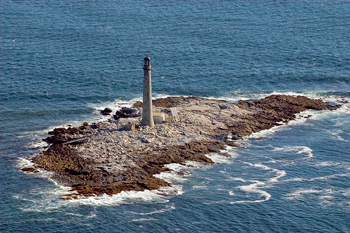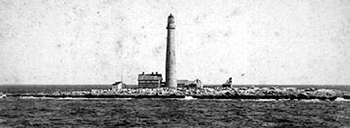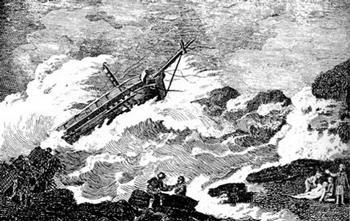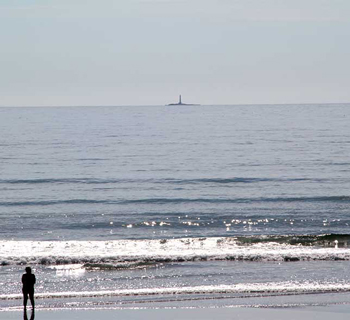Cannibals Off the Maine Coast
by Tom Seymour

Boon Island Light near Cape Neddick, Maine. At 133' it is the tallest in New England. Talk of building a light there began after the Nottingham Galley ran aground on the barren outcrop and sank in 1710. President Monroe ordered a light station tower be built in 1811 just before the War of 1812. NOAA photo.
The often-repeated headline “Cannibals Off The Maine Coast” conjures images of a race of backward humans that somehow managed to practice their unspeakable habits for ages, unbeknownst to the civilized world.
That headline sold plenty of newspapers over the years, but the truth of the matter is something entirely different. The “cannibals” were seamen, stranded on a small island off the southern Maine coast, after their ship went aground and broke up way back in 1710. The true story of the Boon Island survivors is reminiscent of the tale of the Donner Party, a group of migrants that wound up stranded in a snowy, mountain setting and before getting rescued, took recourse to cannibalism. Of the two, the Donner Party participated in the taboo practice to a far greater extent than did the suffering seamen on Boon Island.
Boon Island, 7 miles off of York, Maine, is a barren, rocky shoal of 300 feet X 700 feet at low tide. At high tide, especially during severe storms, the land area decreases considerably and can even vanish completely. Some edible, seaside plants such as orache, goosetongue and sea blite probably exist during the warm season, but in the early winter of 1710, these were not available. The only food came in the form of blue mussels, perhaps a few clams and whatever sea birds a starving human might capture. In other words, being stranded on Boon Island for any length of time amounted to a death sentence in the form of lingering, slow starvation.
One of the more distressing facts regarding the 1710 shipwreck was that the stranded sailors could see the mainland, only 7 miles away. At first this was reassuring. Surely someone would venture near and save them. But just because those on Boon Island could see the mainland did not mean that anyone on the mainland could see them. As time passed, it became clear that help was not forthcoming. Starving, the men began contemplating the unthinkable. All this gives us some background as we investigate the ship and the men behind this most gruesome of Maine stories.
Nottingham Galley

Current 1855 version of Boon Island Light. The surface is just a few feet above mean high water. The granite block tower and house sustained damage during a 1978 winter storm. NOAA photo.
The Nottingham Galley, a vessel of 120 tons and carrying 10 cannon, set sail from London on September 10, 1710, Captain John Deane in command. The Nottingham Galley was part of a convoy of other merchant vessels and was accompanied by two warships of the Royal Navy. Queen Anne’s War, known in America as one of the French And Indian Wars, was raging, thus the need for protection for British merchant vessels.
The Nottingham Galley carried a load of cordage destined for Boston, but left the safety of the convoy to make a brief stop in Ireland to pick up a butter and cheese. On the way, two sails appeared, which the crew considered were probably French privateers. Here the story becomes muddied.
Captain Deane later wrote that he attempted to evade the privateers, but the crew insisted that the captain sailed toward the two ships, in the hopes of being captured and perhaps forced to run aground. This the captain vehemently denied. At this point, the crew is said to have threatened to mutiny. Either way, the captain did evade the enemy ships and the Nottingham Galley continued on toward North America.
Relations were strained between captain and crew. First mate Christopher Langman, along with two other shipmates, accused Captain Deane of attempting to either turn the ship over to French privateers, part of a pre-arranged deal, or to deliberately wreck the vessel and collect the insurance money. The journey from that point on was not a happy one. The captain had a heavy hand with his crew and beat the uncooperative sailors so badly they were unable to perform their duties. Captain Dean also put his sailors on short rations, something that would have a telling affect upon their health and ability to survive after going aground.
Arriving off the coast of Newfoundland, Captain Dean tarried for a week before continuing on to Boston. It was then that a fierce storm struck and the ship ran aground on the inhospitable shores of Boon Island.
Captain Deane, in his notes, wrote, “…it was the beginning of December when we first made land to the eastward of Piscataqua, and proceeding southward for the bay of Massachusetts, under a hard gale of wind at northeast, accompanied with wind, rain, hail and snow, having no observation for ten or twelve days, we, on the 11th, handed all our sails, excepting our fore-sail and maintop-sail double-reefed, ordering one hand forward to look out. Between eight and nine o’clock, going forward myself, I saw the breakers ahead, whereupon I called out to put the helm hard to starboard; but before the ship could wear we struck upon the east end of the rock called Boon-Island, four leagues to the eastward of Piscataquis.”
Boon Island

Artists sketch depicting the Nottingham Galley aground at Boon Island in 1710.
After Nottingham Galley went aground, some accounts claim that the storm snapped the masts and one mast fell from the vessel to the island, giving the 14 men aboard a vehicle upon which to clamber to safety. Other accounts say that the crew chopped the mast down in order to achieve the same effect. Suffice it to say, the entire crew managed to make it to safety via one of the masts. But what kind of safety did this barren, windswept place offer?
The men endured a long, cold first night. They had no way of building a fire, something that were they able to accomplish, might have saved them from their long ordeal. Food, too, was scarce. Except for some timber, sail canvas, ropes and a few scrids of cheese, not much was salvageable from the ship.
Using the canvas, the men built a makeshift tent, where they huddled together at night to keep warm. In time, someone thought to affix a flagpole to the tent, with the hopes that a passing vessel may sight the flag and save the stranded sailors.
On their second day on Boon Island, the men suffered their first casualty. The ship’s cook had died. But at that point, no one entertained any thoughts of using his body as a food source.
The first week saw the men eating what little cheese was left, along with some crushed beef bones. But things were looking bad and so the men fashioned a little boat using what scarce material they could scrounge from the wreck. The ship’s carpenter, though, had fallen ill and could not contribute to the building of this emergency boat. The carpenter later died.
On December 21, everyone concerned concluded that the little boat was seaworthy and he being the most fit at the time, Captain Deane was chosen to serve as skipper. As Deane and six others worked to launch the lifeboat, a huge swell flipped it over and smashed it to atoms. This was terribly disheartening, although at that point the men realized that even were they able to launch their lifeboat, it would probably not have made it to the mainland and all aboard would have perished.
After this, first mate Langman managed to kill what records refer to as a, “seagull.” What kind of gull this was remains a question. Most probably it was a herring gull, a common seabird of the Maine coast. Anyway, lacking a fire, the men consumed the gull raw. Shortly after this, the cook died, but at that point no one considered eating him. Then Langman was able, with the help of a saucepan, to kill another gull which, like its predecessor, was eaten raw.
Despite the failure of the first lifeboat, a Swedish crewman was able to build a two-man raft, which he and another sailor boarded and steered for the mainland. That was the last anyone on Boon Island would see of either men. While the Swede’s body was lost at sea, the other sailor, a paddle tied to his wrist, floated to shore, frozen and emaciated. Bits of the raft were also found.
Thus in death, the unnamed sailor allowed those on shore to deduce what had happened and send an investigation party out to Boon Island, where they supposed the dead man had come from. Those on the island, though, had no way of knowing this and life, for them, continued on a downward spiral. Facing hunger more extreme than any had previously known, the men petitioned Captain Deane for permission to eat the remains of the dead ship’s carpenter.
Seeing no alternative to death by starvation, the captain consented. Since the other men were too ill and weak to perform that which was necessary to render the carpenter’s body ready for consumption, they pleaded with Captain Dean, a former butcher, to perform the act, which he did. Dean disposed of the entrails, head, hands and feet in the sea. He then quartered the body and cut long, thin strips of flesh. These were doused in seawater and eaten along with seaweed, to partially mask the true nature of their meal.
The men ate so ravenously that Captain Deane took the precaution of moving the remainder of the carcass far away from the tent, where the staggering seamen could not pilfer it.
Deliverance

Boon Island Light on the horizon 8 miles distant. In 1710 with no light tower not much of the low island would have been seen from shore. The stranded sailors could have seen the mainland.
On January 2, Captain Deane sighted an approaching shallop, a small sailing vessel, nearing the island. Those aboard were obliged to anchor their vessel about 100 yards from shore, on account of high, treacherous seas. Later, when the seas subsided somewhat, a lone man, John Stover, boarded a canoe and paddled to the island. There, he was met with the most frightening scene.
The shipwrecked sailors were now just skin and bone. Their faces were pinched and covered with the remains of their late, cannibalistic meal. Some clung to Stover’s legs, pleading to be taken off the island. But seas were still rough and when Stover consented to take Captain Dean aboard the canoe, waves flipped it. Stover then helped the men to build a fire, which they not only used to warm themselves, but also to cook what was left of the carpenter’s carcass, thus making their meal less grotesque.
Stover promised that help would arrive the next day, and paddled his canoe back to the shallop, whereupon he and the others aboard sailed back to the mainland.
But the weather turned foul the following day and rescue efforts were put on hold. It wasn’t until January 4 that two sloops arrived at Boon Island to begin the work of bringing the stricken men off the island and to safety. Using a canoe, two or three men at a time were transferred from the island to the waiting sloops. When aboard, the survivors were given bread and rum, which they consumed too much of, too quickly, and became sick. But so nourished, they soon recovered.
Once ashore, the Boon Island survivors were taken to a tavern in Portsmouth, New Hampshire, where as opposed to their feeding on board the sloops, they were allowed to eat only a little at a time, and very slowly. The lieutenant governor, John Wentworth, absorbed the cost of caring for and nursing the sick men back to health.
In addition to food, a doctor saw to the men’s physical condition and amputated numerous frostbitten fingers and toes. The cabin boy had half of one foot removed, the most serious amputation of all.
Meanwhile, Captain Deane, staying at a friend’s house in Portsmouth, wrote an account of the voyage and shipwreck, which he got three crew members to sign. Later, First Mate Langman and two others changed their story. Upon finally returning to London, Langman and the others wrote their own account of the time, an account that differed fundamentally from that of Captain Deane.
Postscript
Whereas Captain Dean’s account painted him as a hero, and the mate’s account placed him at fault for everything, the controversy continued and in fact, was never resolved.
In time, various books would be written about the wreck of Nottingham Galley on Boon Island. One of the better-known accounts was penned by Maine historical novelist, Kenneth Roberts, in his 1956 novel, Boon Island.
A more recent account of the subject, one chapter in the book, Great Shipwrecks of The Maine Coast, Applewood Books, 2010, by Jeremy D’Entremont, gives the reader plenty of opportunity to make up his or her own mind about what really happened.
Finally, in 1995, divers found artifacts on the bottom near Boon Island that are thought to have come from Nottingham Galley. Of these, nine, iron cannon were retrieved, conserved and are now on display in the Maine State Museum in Augusta, Maine.
